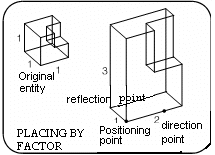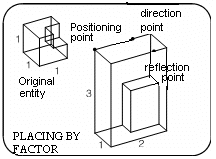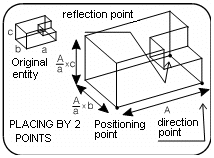Placing an Object with Rotation and Scale
Home > 15 Placed Objects and Libraries > Placing an Object with Rotation and Scale
Placing an Object with Rotation and Scale
Place an object in the model at any position, with any xyz scale factors, and with any orientation in space.
\plrot
Type the name of the object or press Enter for the library dialog box and select the object (see Using the library dialog box).
Choose to rescale the object while placing, or to place the object in its original size. If you choose to rescale, there are two options for defining the scaling factors:
By three scaling factors
Enter the factors by which the X, Y, and Z dimensions of the original object are to be multiplied. Specifying a negative value for any of the factors causes the object to be reflected.


By two points
All dimensions of the model are multiplied by the distance (in meters) between the positioning and direction points. For example, if the distance between the two points is 3m, the entire object is enlarged by a factor of 3.
 HINT If you intend to scale by two points, design the original object with an overall size of 1m. If you do this, the object is stretched or compressed to fit the distance between the two points.
HINT If you intend to scale by two points, design the original object with an overall size of 1m. If you do this, the object is stretched or compressed to fit the distance between the two points.

Regardless of the scaling option that you choose, define the following points:
Positioning point
The origin point of the object is placed at this point.
Direction point
The X axis of the object is aligned between the positioning and direction points.
reflection point
A third point, not on the line between the first two points, defining the rotation of the object in three-dimensional space:
The XY plane of the object is oriented in the plane defined by the three points
The positive Y axis of the object points to the side of the X axis where the reflection point is located.
The three points may be located anywhere in three-dimensional space. This enables you to rotate the object to any desired orientation.
 HINT If the reflection point is located counterclockwise from the positioning-direction point line, the object is placed right side up. If the reflection point is located clockwise from the line, the object is placed upside down; hence the name, "reflection point".
HINT If the reflection point is located counterclockwise from the positioning-direction point line, the object is placed right side up. If the reflection point is located clockwise from the line, the object is placed upside down; hence the name, "reflection point".
The effect is a true reflection only if the object is two-dimensional. If the object is three dimensional, use the three points to establish the orientation, and use a negative scaling factor to achieve a true reflection.
